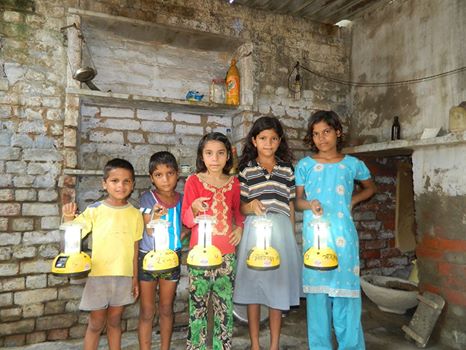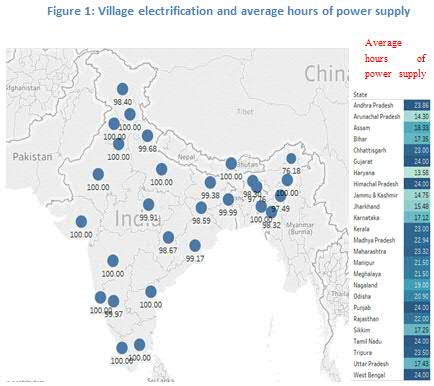Darkness will be ostracized
"Kehdo andhere se kahin aur ghar bana le, mere mulk mein roshni ka sailaab aaya hai" - Shri Piyush Goyal

Back in 2009, over 250 million people lived without access to electricity in India [1]. If all the world's energy-poor (over 1.2 billion people [1]) lived in India and their electricity requirement was limited to basic lighting only, and the solar lantern was all they aspired for, then a targeted development assistance of $12.92 billion would have been sufficient for just procuring a most basic solar lantern that meets international quality standards [2]. This aid would have been almost one-fifth of what non-resident Indians had sent during 2015 to their family, friends or relatives residing in India [3]. In other words, the required targeted funding would have been four-times of the net development assistance and official aid received by India in 2015 [4]. However, needs of the energy-poor are not limited to basic lighting – rather, their needs keep evolving. Also, remittances are leveraged by households for addressing a range of immediate, short-term, mid-term and long-term needs that go beyond electricity needs. The International Energy Agency (IEA) estimated that, between 2010 and 2030, an average annual investment of USD 6.4 billion is required to achieve universal access to electricity in the country per year [1]. Internationally, there has been a constant shout that the development assistance for addressing the challenge of access to electricity has always been short of what is practically required [5].
Yet, as per the Global Tracking Framework (GTF), 2017, with immense impetus on connecting the last mile, between 2010 and 2012, India has made significant strides and provisioned 55 million people with access to electricity [6]. No doubt political will and support from the development agencies have been strong enabling factors. A major thrust in the off-grid sector has come from the private sector and through imports and retail of standalone products and components.

Figure 1: Status of village electrification in India and power supply (Adapted from Martand S, Ipsita S and Deborshri B, 2017. Household Energy. TERI Energy and Environment Data Directory and Yearbook 2017 (forthcoming edition).
(*For Mizoram May, and for Uttarakhand, January month data has been included)
There are states and union territories such as Delhi, Punjab, Haryana, Chandigarh and Daman & Diu which are set as kerosene-free by the government [7]. In small cities such as Bijnor, in the state of Uttar Pradesh, the private sector has completely disrupted the market for kerosene wick lamps which were earlier used for domestic lighting in rural areas. The availability of good quality and poor quality lighting products, such as tubular battery and dry cell-based stand-alone products, that are designed and priced to meet needs of every pocket size has eventually made clean lighting access a reality for a majority of households in urban and rural areas of Bijnor. At the same time, recent improvements in village electrification and an actual increase in a number of hours of reliable grid electricity supply in rural areas has helped in the realization of clean lighting goals for millions of people (Figure 1 presents data for average hours of power supply in rural areas during June 2017 and percentage of villages inhabited Census villages [8][9]).
During a recent visit to Bijnor, local solar shop owners informed about a higher demand for solar panels and hybrid power conditioning units which the relatively better-off households can use to cut on their electricity bills or to prepare for power cuts. Also, most of the retailers informed that a majority of the business comes through the installation of roof-top systems at private schools, petrol pumps, colleges, and other commercial institutions. Households are graduating to clean lighting at a bullet speed.
Yet, amid a race for a market-based solution for access to clean lighting, relevant schemes must be designed to target households of elderly and destitute who live alone with no or limited source of incomes and family support. Stand-alone lighting products (tubular battery and dry cell based products) have proved to be a credible disrupter of the market for kerosene wick lamps. At the same time, the sellers of stand-alone products are facing a tough competition from the centralized grid. Nevertheless, price economics and access to improved energy sources at a price which is affordable are two key parameters which are pulling end users away from the age of kerosene wick lamps. Yes, darkness will be very soon ostracized from every house in this country.
Note: The opinions expressed in this article are the author's own and do not reflect the view of institution (s) to which the author is affiliated or may have been affiliated.
References
- [1] International Energy Agency (IEA), 2011. World Energy Outlook 2011. Energy for All. Financing access for the poor.
- [2] Author's calculation based on price of a most basic and good quality solar lantern available in India
- [3] World Bank, 2016. Remittances to Developing Countries Edge Up Slightly in 2015. Accessed online from http://www.worldbank.org/en/news/press-release/2016/04/13/remittances-todeveloping-countries-edge-up-slightly-in-2015 on 1 September 2017
- [4] World Bank, 2017. Data. Net official development assistance and official aid received (current US$). Accessed online from https://data.worldbank.org/indicator/DT.ODA.ALLD.CD?end=2015&start=2015 on 12 September 2017
- [5] Clean Energy Ministerial. Finance for Energy Access. Last accessed online on 12 September 2017 from http://www.cleanenergyministerial.org/Portals/2/pdfs/CEM6Portal/CEM6_RTFinanceforEnergyAccessRoundtable_Pre-Read.pdf
- [6] Sustainable Energy for All (SE4All), 2015. Progress towards sustainable energy. Global Tracking Framework 2015.
- [7] Lok Sabha, 2017. Starred Question No 219. Direct Benefit Transfer in Kerosene. Last accessed online on 12 September 2017 from http://164.100.47.190/loksabhaquestions/annex/12/AS219.pdf
- [8] Rural Electrification Corporation (REC), 2017. Garv Dashboard. Last accessed online on 12 September 2017 from https://garv.gov.in/garv2/dashboard/garv.
- [9] Lok Sabha, 2017. Unstarred Question No 4043. To be answered on 10.8.2017. Impact of DDUGJY. Ministry of Power. Government of India.

